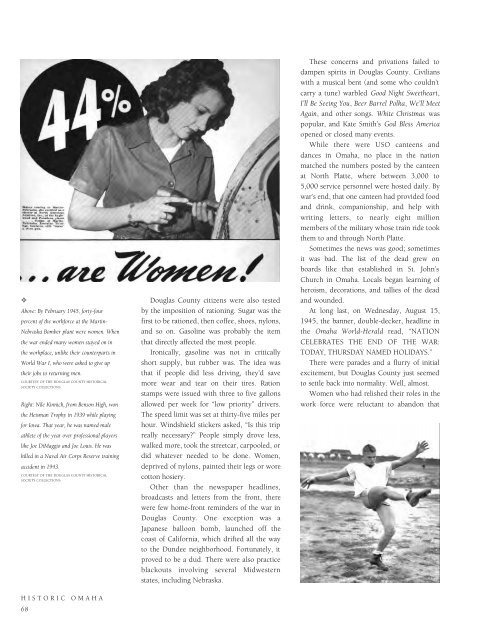Historic Omaha
An illustrated history of Omaha and the Douglas County area, paired with the histories of companies, families and organizations that make the region great.
An illustrated history of Omaha and the Douglas County area, paired with the histories of companies, families and organizations that make the region great.
Create successful ePaper yourself
Turn your PDF publications into a flip-book with our unique Google optimized e-Paper software.
✧<br />
Above: By February 1945, forty-four<br />
percent of the workforce at the Martin-<br />
Nebraska Bomber plant were women. When<br />
the war ended many women stayed on in<br />
the workplace, unlike their counterparts in<br />
World War I, who were asked to give up<br />
their jobs to returning men.<br />
COURTESY OF THE DOUGLAS COUNTY HISTORICAL<br />
SOCIETY COLLECTIONS.<br />
Right: Nile Kinnick, from Benson High, won<br />
the Heisman Trophy in 1939 while playing<br />
for Iowa. That year, he was named male<br />
athlete of the year over professional players<br />
like Joe DiMaggio and Joe Louis. He was<br />
killed in a Naval Air Corps Reserve training<br />
accident in 1943.<br />
COURTESY OF THE DOUGLAS COUNTY HISTORICAL<br />
SOCIETY COLLECTIONS.<br />
HISTORIC OMAHA<br />
68<br />
Douglas County citizens were also tested<br />
by the imposition of rationing. Sugar was the<br />
first to be rationed, then coffee, shoes, nylons,<br />
and so on. Gasoline was probably the item<br />
that directly affected the most people.<br />
Ironically, gasoline was not in critically<br />
short supply, but rubber was. The idea was<br />
that if people did less driving, they’d save<br />
more wear and tear on their tires. Ration<br />
stamps were issued with three to five gallons<br />
allowed per week for “low priority” drivers.<br />
The speed limit was set at thirty-five miles per<br />
hour. Windshield stickers asked, “Is this trip<br />
really necessary?” People simply drove less,<br />
walked more, took the streetcar, carpooled, or<br />
did whatever needed to be done. Women,<br />
deprived of nylons, painted their legs or wore<br />
cotton hosiery.<br />
Other than the newspaper headlines,<br />
broadcasts and letters from the front, there<br />
were few home-front reminders of the war in<br />
Douglas County. One exception was a<br />
Japanese balloon bomb, launched off the<br />
coast of California, which drifted all the way<br />
to the Dundee neighborhood. Fortunately, it<br />
proved to be a dud. There were also practice<br />
blackouts involving several Midwestern<br />
states, including Nebraska.<br />
These concerns and privations failed to<br />
dampen spirits in Douglas County. Civilians<br />
with a musical bent (and some who couldn’t<br />
carry a tune) warbled Good Night Sweetheart,<br />
I’ll Be Seeing You, Beer Barrel Polka, We’ll Meet<br />
Again, and other songs. White Christmas was<br />
popular, and Kate Smith’s God Bless America<br />
opened or closed many events.<br />
While there were USO canteens and<br />
dances in <strong>Omaha</strong>, no place in the nation<br />
matched the numbers posted by the canteen<br />
at North Platte, where between 3,000 to<br />
5,000 service personnel were hosted daily. By<br />
war’s end, that one canteen had provided food<br />
and drink, companionship, and help with<br />
writing letters, to nearly eight million<br />
members of the military whose train ride took<br />
them to and through North Platte.<br />
Sometimes the news was good; sometimes<br />
it was bad. The list of the dead grew on<br />
boards like that established in St. John’s<br />
Church in <strong>Omaha</strong>. Locals began learning of<br />
heroism, decorations, and tallies of the dead<br />
and wounded.<br />
At long last, on Wednesday, August 15,<br />
1945, the banner, double-decker, headline in<br />
the <strong>Omaha</strong> World-Herald read, “NATION<br />
CELEBRATES THE END OF THE WAR:<br />
TODAY, THURSDAY NAMED HOLIDAYS.”<br />
There were parades and a flurry of initial<br />
excitement, but Douglas County just seemed<br />
to settle back into normality. Well, almost.<br />
Women who had relished their roles in the<br />
work force were reluctant to abandon that
















